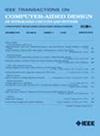Bank on Compute-Near-Memory: Design Space Exploration of Processing-Near-Bank Architectures
IF 2.7
3区 计算机科学
Q2 COMPUTER SCIENCE, HARDWARE & ARCHITECTURE
IEEE Transactions on Computer-Aided Design of Integrated Circuits and Systems
Pub Date : 2024-11-06
DOI:10.1109/TCAD.2024.3442989
引用次数: 0
Abstract
Near-DRAM computing strategies advocate for providing computational capabilities close to where data is stored. Although this paradigm can effectively address the memory-to-processor communication bottleneck, it also presents new challenges: The strict resource constraints in the memory periphery demand careful tailoring of architectural elements. We herein propose a novel framework and methodology to explore compute-near-memory designs that interface to DRAM memory banks, demonstrating the area, energy, and performance tradeoffs subject to the architectural configuration. We exemplify this methodology by conducting two studies on compute-near-bank designs: 1) analyzing the interaction between control and data resources, and 2) exploring the integration of processing units with different DRAM standards. According to our study, the optimal size ratios between instruction and data capacity vary from计算-近存银行:处理近存储架构的设计空间探索
近内存计算战略主张在数据存储地附近提供计算能力。虽然这种模式可以有效解决内存到处理器的通信瓶颈,但也带来了新的挑战:内存外围严格的资源限制要求对架构元素进行精心定制。在此,我们提出了一种新颖的框架和方法,用于探索与 DRAM 存储库接口的计算近程内存设计,并展示了受架构配置影响的面积、能耗和性能权衡。我们通过对计算近端存储器设计进行两项研究来体现这一方法:1) 分析控制资源和数据资源之间的相互作用;2) 探索不同 DRAM 标准的处理单元的集成。根据我们的研究,在具有代表性的应用领域基准中,指令和数据容量之间的最佳大小比从 2 美元/次到 4 美元/次不等。从我们的框架中检索到的帕累托最优解决方案改进了最先进的设计,例如,与 FIMDRAM 设计相比,矩阵运算的性能提高了 50%,而能量开销仅为 15%。此外,对 DRAM 的探索显示了可用内部带宽、性能和面积开销之间的相互作用。例如,将带宽提高三倍可将各种工作负载的性能提高 47%,而额外的面积成本为 34%。
本文章由计算机程序翻译,如有差异,请以英文原文为准。
求助全文
约1分钟内获得全文
求助全文
来源期刊
CiteScore
5.60
自引率
13.80%
发文量
500
审稿时长
7 months
期刊介绍:
The purpose of this Transactions is to publish papers of interest to individuals in the area of computer-aided design of integrated circuits and systems composed of analog, digital, mixed-signal, optical, or microwave components. The aids include methods, models, algorithms, and man-machine interfaces for system-level, physical and logical design including: planning, synthesis, partitioning, modeling, simulation, layout, verification, testing, hardware-software co-design and documentation of integrated circuit and system designs of all complexities. Design tools and techniques for evaluating and designing integrated circuits and systems for metrics such as performance, power, reliability, testability, and security are a focus.

 求助内容:
求助内容: 应助结果提醒方式:
应助结果提醒方式:


